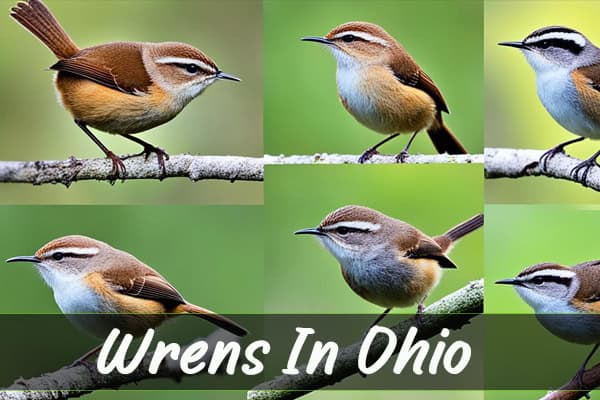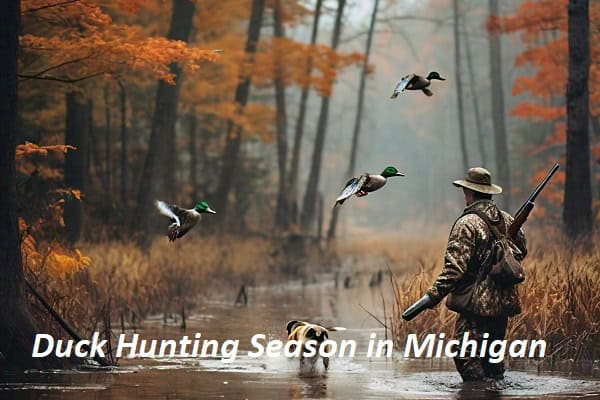6 Species Of Wrens In Ohio (ID Guide With Pictures)
Wrens In Ohio is a haven for bird lovers, with almost 450 bird species. Among these, the Wren family stands out for their charm and diversity. Let’s explore the different types of wrens found in Ohio and where you can spot them.
Birding Hotspots: Explore the State’s Wren-Filled Wonders
Ohio has many protected areas and birding spots perfect for seeing wrens. Some top places to visit include:
- Killdeer Plains Wildlife Area
- Metzger Marsh Wildlife Area
- Magee Marsh Wildlife Area
- Sheldon Marsh State Nature Preserve
- Headlands Beach State Park
- Oak Openings Preserve Metropark
- The Lake Erie Birding Trail
These places are important for wrens and other birds, letting visitors enjoy Ohio’s bird diversity.
If you love birds or nature, Ohio’s wrens are waiting for you. You can hear the Carolina wren’s song or the winter wren’s trill. Ohio’s wrens are a sight to see.
1. Carolina Wren
- Scientific name – Thryothorus ludovicianus
- Lifespan – 6 years (average), 7 years (maximum recorded)
- Size – 4.7 to 5.5 in
- Weight – 0.6 to 0.8 oz
- Wingspan – 11 to 11.4 in
The Carolina Wren is a beloved bird in many Ohio yards. It’s small, with reddish-brown feathers and a white eyebrow. You’ll see it hopping around, often on feeders or in cozy spots.
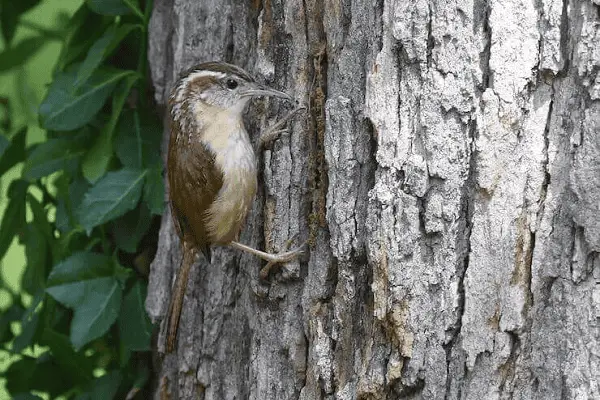
Nesting Habits of the Carolina Wren
Carolina Wrens are creative nesters. They like to build their nests in tree cavities, stumps, or overhangs. Sometimes, they nest on the ground or in thick plants. In cities, they might pick mailboxes or flowerpots for their homes. Their nests are made from things like bark, feathers, and straw.
Diet and Conservation
Carolina Wrens eat mostly insects like spiders and crickets. They also eat small snakes, frogs, and lizards, and sometimes fruits and seeds. This bird is common and its numbers are growing. It likes forests and cities, making it easy to spot.
Where to Find Carolina Wrens in Ohio
To see a Carolina Wren in Ohio, look in places like cypress swamps and wooded areas. They’re common and can be found in many parts of the state. Great spots to see them include the Cleveland Lakefront Nature Preserve, Magee Marsh Wildlife Area, Killdeer Plains Wildlife Area, Metzger Marsh Wildlife Area, and Headlands Beach State Park.
“The Carolina Wren’s cheerful, whistled song is a delightful addition to any backyard soundscape.”
2. Winter Wren
- Scientific name – Troglodytes hiemalis
- Lifespan – 2 years (average)
- Size – 3.1 to 4.7 in
- Weight – 0.3 to 0.4 oz
- Wingspan – 4.7 to 6.3 in
The Winter Wren is a small, plump bird that lives in Ohio’s evergreen forests. It has a short tail and brown feathers with bars on its tail, wings, and belly. The belly is lighter, and its bill is dark and thin.
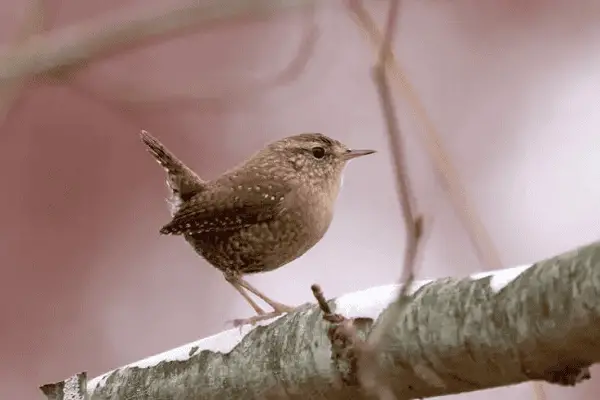
It sings a bubbly song that lasts five to ten seconds. This bird sings the loudest song for its size among all birds. In spring and summer, it sings from a stump or branch in the forest understory.
Winter Wrens build nests that look like domes or use cavities in trees or logs. They use bark, moss, twigs, and other plant materials to build their nests. These nests are lined with feathers and animal hair.
They eat insects like ants and beetles, as well as spiders and berries. They like old-growth forests but are threatened by logging and forest loss.
In Ohio, Winter Wrens stay all year but are most common in winter. You can see them at places like the Cleveland Lakefront Nature Preserve and Killdeer Plains Wildlife Area.
Finding the Winter Wren can be hard because it’s small and hides well. But its song and behavior are worth the effort. By protecting its forests, we can keep the Winter Wren in Ohio for a long time.
3. Marsh Wren
- Scientific name – Cistothorus palustris
- Lifespan – Unknown
- Size – (10 to 14 cm)
- Weight – (9 to 14 g)
- Wingspan – (14 to 17.8 cm)
When you explore Ohio’s lush cattail marshes and sedge-filled wetlands, you might see a Marsh Wren. This small bird is a pro at staying hidden, moving through thick vegetation with ease. It also makes a lot of noise, which can catch your attention.
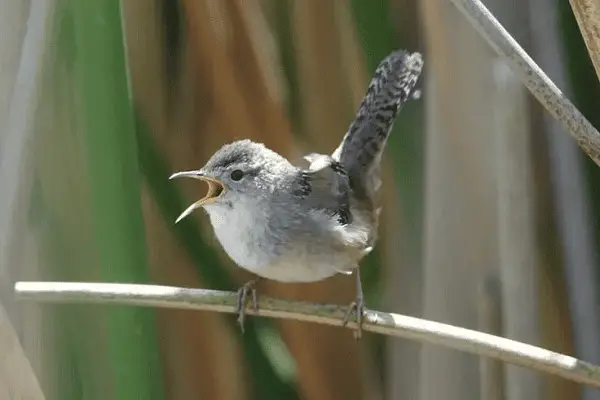
Nesting and Breeding Behavior
Marsh Wrens make their homes in tall cattails and bulrushes. They build a dome-shaped nest with grass, sedge, and cattail. The nest has a hole on top and a soft cup for the eggs, which are lined with feathers and other materials.
The female lays three to ten eggs that are dark-spotted and brown. She incubates them for 12 to 16 days. After 13 to 15 days, the baby wrens learn to survive in their wet home.
Diet and Conservation
Marsh Wrens eat insects like damselflies mosquitoes, and spiders too. They help control pests in wetlands. Despite being hard to see, they are quite common, with about 9.4 million breeding pairs worldwide. However, their homes are being destroyed, putting them at risk.
Prime Locations to Spot Marsh Wrens in Ohio
In Ohio, you can find Marsh Wrens in saltmarshes with cordgrass and freshwater wetlands with sedges and cattails. They also like thickets near wetlands and agricultural canals in the winter. Good places to see them include the Fernald Preserve and other nature spots in Ohio.
“Marsh wrens are known for their enthusiastic vocalizations dominated by a high-pitched, buzzing trill. Observing or photographing marsh wrens requires patience and effort, often involving wading into dense cattail stands.”
4. House Wren
- Scientific name – Troglodytes aedon
- Lifespan – 9 years (maximum recorded)
- Size – (11 to 13 cm)
- Weight – (10 to 12 g)
- Wingspan – (15 to 16.5 cm)
The house wren (Troglodytes aedon) is a common bird in many Ohio backyards and gardens. It’s small, lively, and loves to sing. Homeowners and bird lovers enjoy watching these birds.
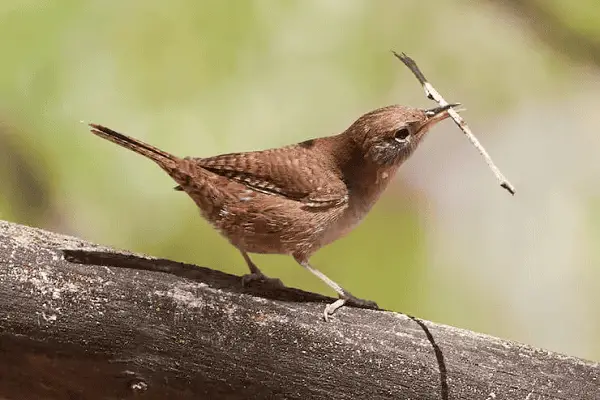
Nesting Habits and Quirks of House Wrens
House wrens are clever at finding places to nest. They use natural spots, old woodpecker holes, and nest boxes. Their nests are made of sticks and twigs, with a soft inside for the eggs.
They often fill many cavities with nesting material, even if they won’t use them all. This helps keep other birds away. The female lays three to ten eggs, which are white or grey with reddish spots. The eggs hatch after 9 to 16 days, and the young birds leave the nest in 15 to 17 days.
Feeding Preferences of House Wrens
House wrens eat insects and spiders like flies, beetles, and caterpillars. They also eat small snails sometimes. These birds are very protective and can be aggressive. Males often mate with many females and build nests for each one.
House wrens are not considered endangered, but some island populations are at risk. This is due to habitat loss, predators, and extreme weather.
5. Rock Wren
- Scientific name – Salpinctes obsoletus
- Lifespan – Unknown
- Size – (12.5 to 15 cm)
- Weight – (15 to 18 g)
- Wingspan – (22 to 24 cm)
In Ohio, the Rock Wren is a standout bird that lives on cliffs. These small birds are great at living in dry, rocky places. They show how well they can adapt and survive.
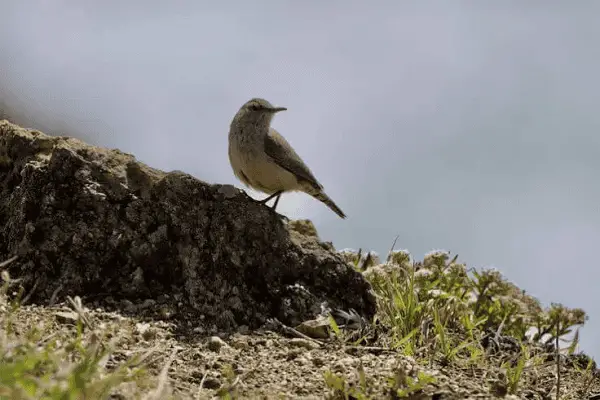
Nesting and Breeding Behavior of Rock Wrens
Rock Wrens make their homes in spaces between rocks or on the ground in rocks. Their nests are shaped like cups and are made from bark, grass, moss, and hair. They line their nests with spider silk, hair, wool, or rootlets. The nests often sit on a base of small stones or sticks.
The female lays 4 to 8 white eggs with reddish-brown spots. It takes about 14 to 16 days for the eggs to hatch. After that, the babies stay in the nest for another 14 to 16 days before they leave.
Diet and Habitat Preferences of Rock Wrens
Rock Wrens eat insects such as leafhoppers, grasshoppers, ants, beetles, and crickets. They also eat some plants, seeds, and spiders. These birds like living in dry, rocky places with not much vegetation. They can be found in areas like shrubsteppe, cliffs, and canyon walls.
| Nesting Behavior | Feeding Habits | Habitat Preferences |
|---|---|---|
|
|
|
The Rock Wren loves living in Ohio’s rugged places. Its unique way of nesting and finding food makes it interesting to watch. It’s a symbol of Ohio’s diverse bird life.
“The Rock Wren, with its remarkable ability to thrive in Ohio’s most rugged and arid habitats, is a testament to the incredible diversity of the state’s birdlife.”
Check Our Previous Articles:
6. Bewick’s Wren
- Scientific name – Thryomanes bewickii
- Lifespan – 8 years (maximum recorded)
- Size (13 cm)
- Weight – (8 to 12 g)
- Wingspan – 7 in (18 cm)
Bewick’s Wren is a rare sight in Ohio, but its visits are a treat for bird lovers. It stands out with its long, thin bill and long tail. The wren’s upper parts shine in light brown, and its belly has a warm, buffy tint. Its back, tail, and wings show off speckles, and a pale stripe on its face adds to its beauty.
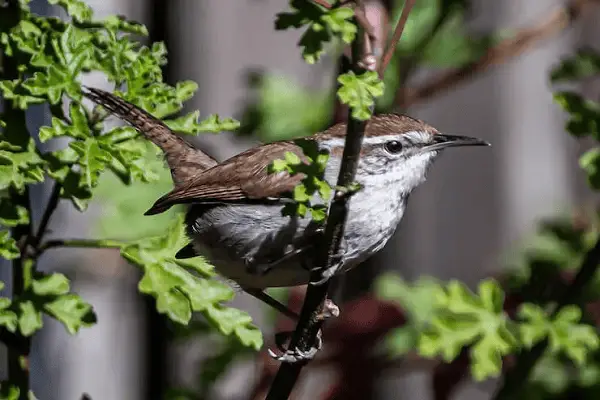
The wren’s song is as diverse as it is beautiful. It sings “keree-keree-keree,” “chair-chair-chair-chair,” and more. These sounds take you to the dry, rocky places where they live, from deserts to mountains.
Bewick’s Wrens build their nests in rock cavities or on the ground. They use bark, grass, moss, and hair to make a cup-shaped home. The nests are lined with spider silk and other materials. They eat insects and some plants, making them interesting to watch.
Frequently Asked Questions:
Q1: What kind of wren is in Ohio?
The most common wren in Ohio is the House Wren.
Q2: Do wrens stay in Ohio in the winter?
Most wrens migrate south for the winter, but some Carolina Wrens may stay in Ohio year-round.
Q3: What are wrens famous for?
Wrens are famous for their loud and complex songs.
Q4: Why are wrens special?
Wrens are special because of their energetic behavior, intricate nests, and vibrant singing.

